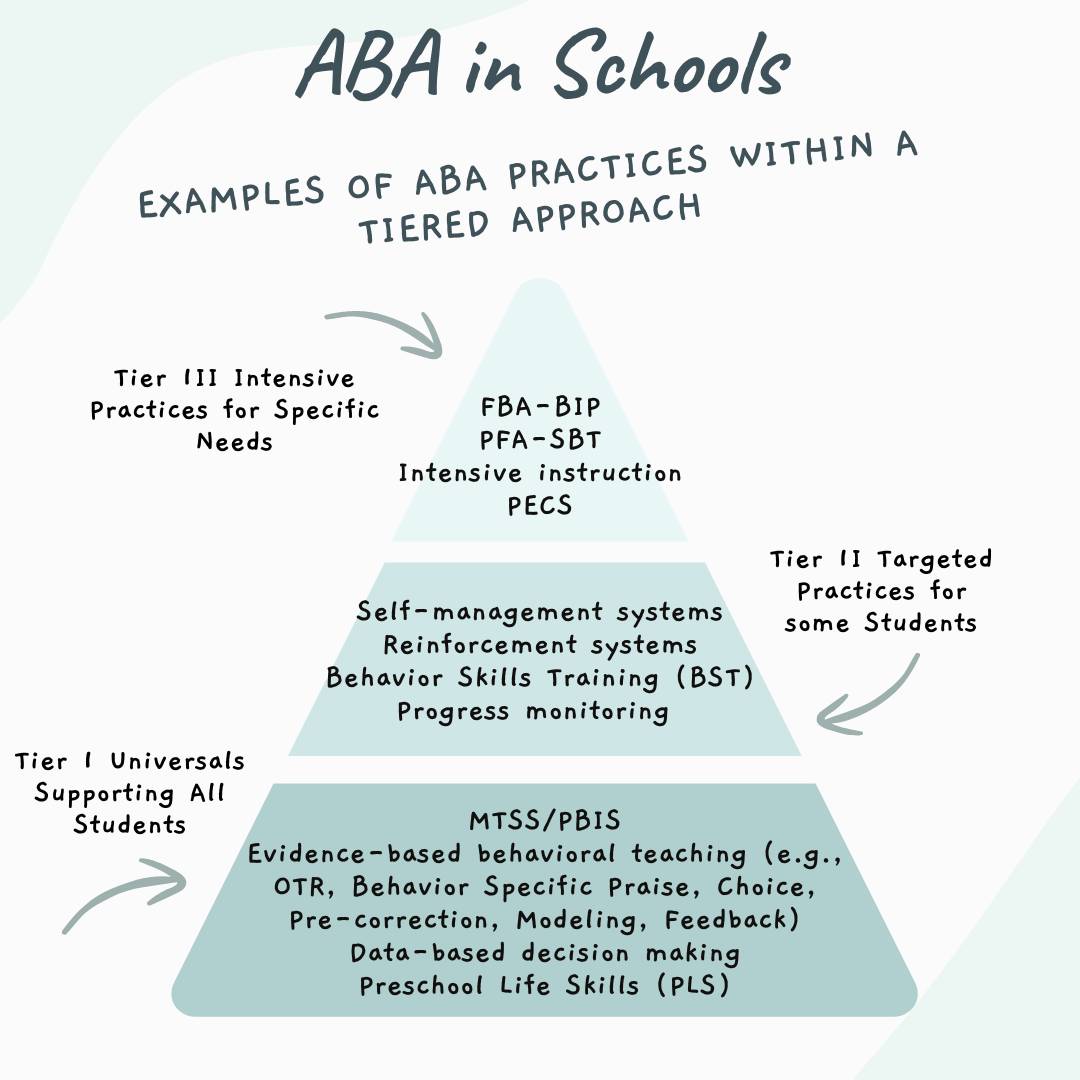Applied Behavior Analysis (ABA) in Schools: Supporting Students with Autism within a Tiered Approach

This article originally appeared in START Connecting in January 2023.
Applied Behavior Analysis (ABA) is a science of behavior change supported by decades of research. Numerous evidenced-based interventions have been derived from the principles of ABA and used to support learners both with and without IEPs, across the school day. For students with autism, the science of ABA is a gold standard of intervention since there are hundreds of studies showing it is the most effective approach for teaching skills and reducing interfering behaviors.
In a previous START Connecting article titled Applied Behavior Analysis (ABA) in Schools: Understanding the Fundamentals to Effectively Use ABA, we focused on the ways ABA is used for behavior change: to increase behaviors, decrease behaviors, and specify the context. In this article, we will highlight ways that ABA practices may support behavior change through: 1) Tier I (universal) support for all learners in a school, and 2) Tier II (targeted) and Tier III (intensive) behavior change strategies for specific learner needs. Integral to this progressive approach to using ABA in schools is an emphasis on dignity and respect for learners and a positive relationship.
You may be familiar with a tiered model of intervention since it is associated with Multi-tiered Systems of Support and Positive Behavioral Interventions and Supports. Thinking of ABA interventions within this system is logical given there is a “familial alliance” between PBIS and ABA (Dunlap et al. 2008). Horner and Sugai (2015), key founders of School-Wide PBIS (SWPBIS) within a tiered model, describe SWPBIS as “applied behavior analysis implemented at a scale of social importance.” What does this mean? If a school building is implementing MTSS, PBIS, or SWPBIS, they are incorporating ABA into their systems to support students.
How does this system support students with autism? First, recall that Tier 1 interventions are available to all students, including students with autism, and involve a school-wide behavior support system, evidenced-based behavioral teaching practices, and data-based decision making. It may also include prevention-based curriculum such as Preschool Life Skills (PLS). At Tier II, targeted interventions are used to support the specific needs of some students, including students with autism, and may include self-management systems, reinforcement systems, and teaching specific skills. These interventions often have a basis in ABA principles and practices such as prompting, reinforcement, modeling, self-evaluation, and progress monitoring.
Tier III involves the use of a focused assessment and intensification of interventions to address learning and behavior challenges and requires a team-based approach to address the specialized needs of a student. Typically, a functional behavior assessment (FBA) is conducted to identify the function(s) of challenging behaviors and a behavior intervention plan (BIP) is carefully crafted to prevent challenging behaviors in the future, teach new skills, and differentially reinforce behaviors. This function-based approach is a hallmark of applied behavior analysis, and FBAs, a requirement of IDEA, are used to create a hypothesis of functions. Students with the most significant challenges may need even more specialized behavior support through a protocol called Practical Functional Assessment and Skill-based Treatment. This protocol is typically supervised by a Board Certified Behavior Analyst (BCBA) in the school.
Tier III supports may include intensification of educational interventions for learning, communication, or social challenges. Interventions with a basis in ABA may involve use of the Picture Exchange Communication System (PECS), embedded discrete trial teaching, or intensive skill-based treatment. At this level of intervention, sufficient training and supervision is necessary to ensure the program is implemented with high fidelity and ongoing data analysis is conducted to evaluate progress.

Given that ABA is considered a gold standard for working with students with autism, it is critically important for school-based staff to know behavioral science and effectively implement ABA practices to educate students with autism. An easy place to start is self-directed learning through the free AFIRM modules or the AIM modules, which are evidence-based practices for autism, many of which are behaviorally-based.
A next step is to work with your ISD or district leaders to seek out additional professional development opportunities, which may include trainings, readings, book studies, and conferences focused on ABA. You might consider attending the Michigan Autism Conference, which has many ABA-focused sessions. For the most enthusiastic staff member, investigate becoming a Board Certified Behavior Analyst (BCBA). It is a demanding certification, but it is certainly worthwhile for the benefit of all students. Every ISD and district would find value in having at least one staff member who is a BCBA.
We encourage you to learn more about ABA in schools by checking out a mini course developed by the authors of this article to teach school staff and administrators about ABA in schools. This free course through Michigan Virtual University has 2 SCECHs available.
By Amy Matthews, Ph.D., BCBA (Project Director) and Stephanie Dyer, Ed.S., BCBA (Autism Education and Intervention Specialist)
Resources
- ABA in Schools – free, Michigan Virtual University mini course
- AFIRM modules
- AIM modules
- Michigan Professional Learning Community - ABA in Schools
- ABA Fact Sheet - Family Matters by Michigan Alliance for Families and MDE, OSE
Additional Information
ABA as an insurance-funded service for autism is based on the same principles and practices described above, but is set up in a different delivery system with oversight by Board Certified Behavior Analysts. For more information, see the resource provided by the Council for Autism Service Providers and the Family Matters Autism Insurance, Medicaid, and Education Fact Sheet.

